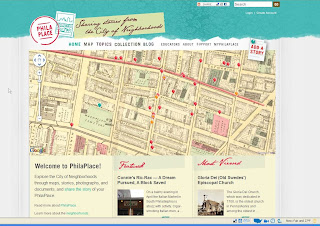PhilaPlace

After almost a year of personal anticipation, I'm excited to announce that PhilaPlace is finally here! I had the pleasure of meeting Joan Savarino at the 2009 NCPH conference in Providence and hearing about this project as it neared the final stages of its development. In May, I attended a session at AAM, where my curiosity about this project was further stoked thanks to an intriguing presentation from the project's technical partner, Night Kitchen Interactive. From conception to completion, the PhilaPlace team has made a concerted effort to keep abreast of the latest trends in social history and in web 2.0 technology; their efforts have clearly paid off.
Enough introduction already-- what is PhilaPlace? PhilaPlace is a map-based interactive website all about the history of Philadelphia's neighborhoods. Oral history, archival documents and photographs combine with user-generated stories and videos to highlight significant places on the changing map of greater Philadelphia. Maps provide the fabric on which the content of this website can be accessed. The visitor can choose to view a contemporary streetscape on a present-day map, a 1962 land-use map, or maps from 1934, 1895 or 1875. Stories and images that appear as sites on this interactive map can be filtered by historical topic, contributor or neighborhood.
The website also provides a portal to a rich archive of content--- a feature that has become par for the course in well-designed digital humanities programs. This union of primary sources and snappy interactive features gives PhilaPlace the trappings of an excellent educational resource. PhilaPlace takes the content-based approach to providing educational resources preferred by many educators. (If you're curious about the opinions of some educators on digital primary sources, check out this survey I conducted last year on that very topic. Just let me know and I'll email you the password.) Instead of providing moment-by-moment lesson plans, PhilaPlace provides timelines, oral history resource lists and well-documented historical background, leaving the specifics to the educators.
One thing that PhilaPlace has that other public history websites may not have is a real-world component. The Historical Society of Pennsylvania has developed a program of guided tours of the Northern Liberties and Soutwark neighborhoods of Philadelphia, appealing to a demographic desirous of an on-the-ground guided experience. As PhilaPlace grows both online and in the city itself, I will be interested to learn how these two modes of exploration complement one another.
Comments